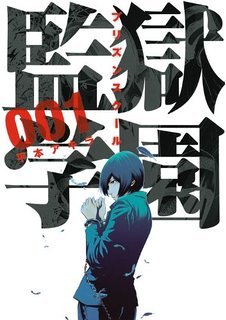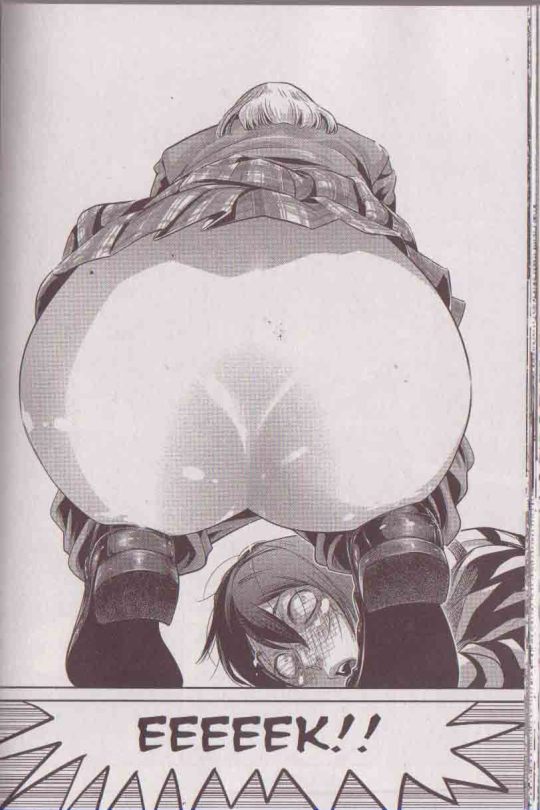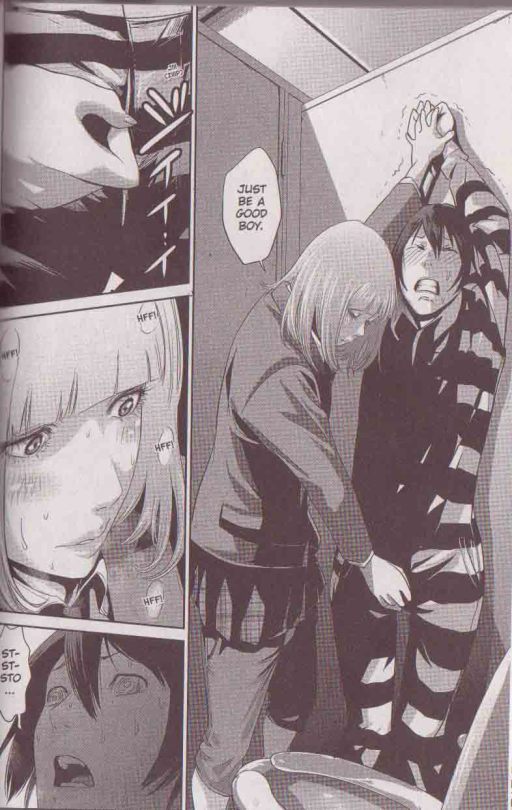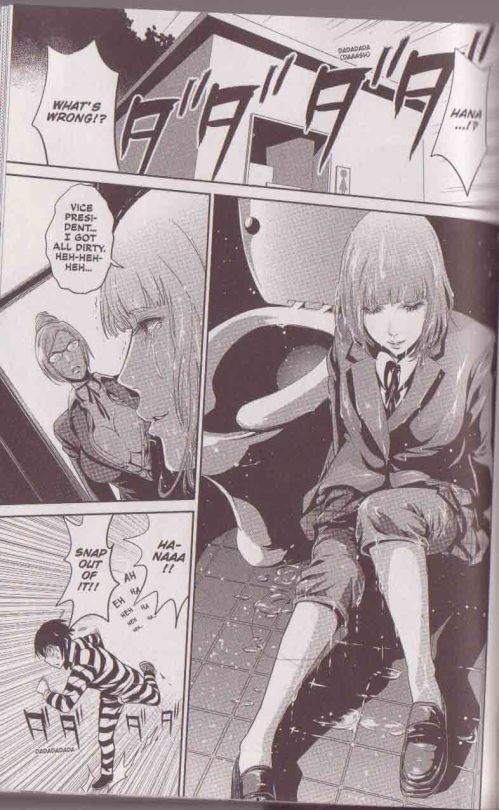The Contagion of Perversity in Akira Hiramoto’s Prison School Vol. 1
When we talk about perversity what we’re talking about is not per se an observation by the subject about itself, but rather we are talking about a social recoil from a pattern of behavior. Perverse behavior is a judgement about the tenuous nature of social codes which we believe create civilization, which separates our living from the dying of the animalistic. Perversity is reacted to like a contagion. A viral idea of behavior that threatens the sexual safety of the objective viewer. Of course this recoil also creates it’s own eroticism, because when we talk about perversity we are talking about sexual inclinations that aren’t perceived to be for any purpose but their own. There’s a foundational accusation of selfishness that accompanies the charge of perversity. The pervert is a sub-human who in their inability to control their shameful urges, threatens our own sense of self and rightness. And of course perversion also creates the system of codes and transgressions which make up romance and desire, which are important aspects of our denial of death. Romance is fundamentally the set of behaviors that govern our ability to incarnate love, which is as close a mental state as we can create in ourselves to being outside of ourselves and built beyond ourselves toward the kind of ideals which perpetuate the desire to live.

Akira Hiramoto’s Prison School Vol. 1 is a comic book published by Yen Press. Prison School is the story of an elite all-girls boarding school which has decided to become co-educational through the admittance of five young boys. These boys: our central protagonist Kiyoshi; Gakt; Joe; Shingo; and Andre joined the school upon the supposition that since they were the only five boys in an all-girls school with a ratio now of 200:1 girls to boys, that they stood a chance of accomplishing their boyish desires with the women of the school. It doesn’t really work out that way though, because for one, the girls at the school have no interest in them, and treat them largely as alien outsiders; and two there is a shadow student council that runs the school and has forbid their interaction. This initial stifling of the boys perversity, leads them to try and peep on the girl’s bath. They are caught, and sentenced to a mysterious Prison School which exists adjacent to the boarding school where the boys are made to wear prison jumpsuits and exist under the perverse authority of their warden’s The Vice President of the Student Council: Meiko; and Secretary Hana–under the overall governorship of the President Mari, whose father has recently taken charge of the school as a whole, and whose idea, it was to admit the boys in the first place.
Hiramoto draws these characters with a kind of perverse paranoia. With malevolent stress lines around the eyes, sweating shifty glances the game Hiramoto is playing aesthetically is largely a comedy of textures with a dark erotic undertone played straight up. This comes across through Hiramoto’s choice of composition. Characters don’t really pop out of frames like you would expect in these kind of comics. There is very little winking to the camera. And generally speaking, the art style mirrors Japanese slice of life comic rules. This is interesting because the actual story is straight trash exploitation genre–but it’s done with a level of rigidity(which isn’t to say there aren’t jokes here, there are, there are a lot of prison movie references and visual quotes) that almost demands shock and recoil at some of its most perverse moments.
There’s one particular section in the book’s narrative that I think is a good place to see what I’m talking about. To set it up, you first have to understand, that for the most part most of the up-skirt shots in this comic are tied around the character Meiko, the dominatrix prison guard vice president of the shadow council. Meiko is an exhibitionist, and even though she is in charge of the punishment of the boys, and even though the boys initially enjoy their shame and punishment at her hands, there is a lot of indication that Meiko is aware of this, and that this is a game of which she is quite aware of the rules. The President of the school observes what is happening and sends in the Secretary Hanna, who in difference to the Vice President, who is more than happy to sit on the boys faces till they pass out, Hanna wears sweatpants under her skirt, and basically kicks the shit out of them whenever she feels like it. This is important in terms of distinction because she is not an exhibitionist, at least openly, in the way that Meiko is. So where the up-skirt peeps that the boys get with Meiko are largely consensual. This page with Hanna peeing is not.

Hanna ends up wanting reciprocation on her shame, and forces Kiyoshi, also without his consent, to pee in front of her. Hiramoto actually shows the construction of a particular kind of perversion with Hanna.

The weight with which Hiramoto draws this page gives it a kind of horrific tension. Hana is sexually assaulting Kiyoshi, and Hiramoto isn’t playing that light which is weird dynamic for a book like this, but it’s why it’s interesting. Hanna’s assertion here is frightening but it also represents a dramatic reversal of the scene where she was exposed, which even that page is drawn with less rendering and is a “lighter” page overall. Here we’re drenched in shadow and grayscale, and the bathroom feels cramped not only by its architecture, but by Kiyoshi’s panic and lack of control of the situation. Kiyoshi in contrast to the other boys in the story is a “good boy” (which makes Hanna’s usage here dramatically ironic), where someone like Gakt welcomes violation from Meiko–Kiyoshi does not. He is debased here as much as Hanna.
Through her interactions with Kiyoshi, Hiramoto gives us something subtle in her expressions that is fairly subtle, but she becomes someone different when she is in private with Kiyoshi talking about their shared shame, and when she finally forces Kiyoshi to pee for her, he of course pees on her, but rather than be alarmed in the way that she did when Kiyoshi saw her pee, her expression is actually a satiated expression, she even jokes ludely(shown in a different font) to the vice president about her defilement.

What’s interesting in this moment for me is that the moment isn’t for Kiyoshi. When Kiyoshi first sees Hanna we can’t see her face, we watch Kiyoshi’s reaction to her peeing. But this arc isn’t really about Kiyoshi, what’s interesting about this whole arc is that it is about the construction of Hanna’s perversity. If at the beginning Hanna is just this faceless butt–she ends up as a pervert of her own agency. This debased Hanna is an expression of her reconciliation and ownership of her shame. I think this point comes across most effectively because the art style Hiramoto employs doesn’t play this whole scenario for ridiculousness. The situation is ridiculous, but the things that are occurring for Hanna as a character are layered and nuanced and a lot of this is because of the tone of Hiramoto’s style.
And in some respect that’s what Prison School Vol. 1 is about. Even though the book focuses on the boys of the story the most time wise, much of the character growth, and overarching thematic decisions are made by the women of the book as they seek to reconcile their relationship to perversion.

While fan of the art style the story is rather cliche